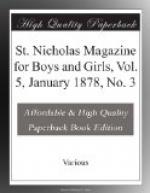By the time the party came, everything was ready. Polly was very good, and let the girls play with her beautiful Rosalinda the whole time. I do not know how long the good will last. I hope till every one forgets to call her Discontented Polly, and learns to call her Darling Polly instead.
[Illustration]
JACK-IN-THE-PULPIT.
Well, my dears, spring is here at last, and it is very pleasant to see the buds and flowers again. I begin to hear the voices of the children more often, too; and now and then I catch a glimpse of bright faces and new dresses.
By the way, talking of dresses puts me in mind of a paragram that came the other day, about
TRIMMINGS FOR COWS.
Something quite new to you, I dare say, for which of you ever heard of trimming cows with their own horns and ears? How should you like to see a cow with her ears—poor thing!—cut to the shape of a leaf with notched edges, and horns trained in some queer shape, twisted into curls, or divided into four, with two meeting overhead, and two turned down toward the ground? It would be a dreadful sight to me, I am sure; but the Africans admire such things. They consider this trimming of cows a sort of fine art. You don’t see how they manage the horns? Well, they begin when the horns are young; divide each into two, or more, and gradually train them, while growing, in any way they choose. Of course it must hurt the poor cows, and take a great deal of time; but the people who train cows’ horns have not very tender feelings, and they are richer in spare time than in anything else. Besides, they do not have to trim their own clothes much—they’re savages.
FEET AND WINGS.
I have been told that flies have suckers on their feet, and climb up window-panes by using them, much as boys lift smooth stones with a piece of soaked leather and a string. Is this so, little folks?
By the way, while you are thinking of flies, I once heard some schoolma’ams (I’m sure our little one was not among them) disputing about the number of wings that a house-fly ought to have. And they said, though it’s hard to believe, that over the door of the Masonic Temple at Boston there are bees, cut in the stone, each with only wings enough for a fly!
Perhaps the sculptor had been reading Virgil before carving those bees, for, as I’ve heard, that ancient poet in one of his writings made a mistake as to the number of a bee’s wings.
CETUS, NOT CYGNUS.
One of my sharp eyed chicks, S.E.S., of Canandaigua, sends word that the star Mira, of which I told you last month, is in the star-group Cetus (the Whale), not in Cygnus (the Swan). S.E.S. is right, I find, and I’m much obliged to her.




